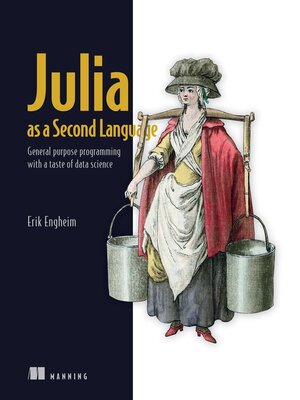
Sign up to save your library
With an OverDrive account, you can save your favorite libraries for at-a-glance information about availability. Find out more about OverDrive accounts.
Find this title in Libby, the library reading app by OverDrive.



Search for a digital library with this title
Title found at these libraries:
| Library Name | Distance |
|---|---|
| Loading... |
Learn the awesome Julia programming language by building fun projects like a rocket launcher, a password keeper, and a battle simulator.
Julia as a Second Language covers:
Data types like numbers, strings, arrays, and dictionaries Immediate feedback with Julia's read-evaluate-print-loop (REPL) Simplify code interactions with multiple dispatch Sharing code using modules and packages Object-oriented and functional programming styles
Julia as a Second Language introduces Julia to readers with a beginning-level knowledge of another language like Python or JavaScript. You'll learn by coding engaging hands-on projects that encourage you to apply what you're learning immediately. Don't be put off by Julia's reputation as a scientific programming language—there's no data science or numerical computing knowledge required. You can get started with what you learned in high school math classes.
About the Technology
Originally designed for high-performance data science, Julia has become an awesome general purpose programming language. It offers developer-friendly features like garbage collection, dynamic typing, and a flexible approach to concurrency and distributed computing. It is the perfect mix of simplicity, flexibility and performance.
About the Book
Julia as a Second Language introduces Julia by building on your existing programming knowledge. You'll see Julia in action as you create a series of interesting projects that guide you from Julia's basic syntax through its advanced features. Master types and data structures as you model a rocket launch. Use dictionaries to interpret Roman numerals. Use Julia's unique multiple dispatch feature to send knights and archers into a simulated battle. Along the way, you'll even compare the object-oriented and functional programming styles–Julia supports both!
What's Inside
Data types like numbers, strings, arrays, and dictionaries Immediate feedback with Julia's read-evaluate-print-loop (REPL) Simplify code interactions with multiple dispatch Share code using modules and packages
About the Reader
For readers comfortable with another programming language like Python, JavaScript, or C#.
About the Author
Erik Engheim is a writer, conference speaker, video course author, and software developer.
Table of Contents
PART 1 - BASICS
1 Why Julia?
2 Julia as a calculator
3 Control flow
4 Julia as a spreadsheet
5 Working with text
6 Storing data in dictionaries
PART 2 - TYPES
7 Understanding types
8 Building a rocket
9 Conversion and promotion
10 Representing unknown values
PART 3 - COLLECTIONS
11 Working with strings
12 Understanding Julia collections
13 Working with sets
14 Working with vectors and matrices
PART 4 - SOFTWARE ENGINEERING
15 Functional programming in Julia
16 Organizing and modularizing your code
PART 5 - GOING IN DEPTH
17 Input and output
18 Defining parametric types
Julia as a Second Language covers:
Julia as a Second Language introduces Julia to readers with a beginning-level knowledge of another language like Python or JavaScript. You'll learn by coding engaging hands-on projects that encourage you to apply what you're learning immediately. Don't be put off by Julia's reputation as a scientific programming language—there's no data science or numerical computing knowledge required. You can get started with what you learned in high school math classes.
About the Technology
Originally designed for high-performance data science, Julia has become an awesome general purpose programming language. It offers developer-friendly features like garbage collection, dynamic typing, and a flexible approach to concurrency and distributed computing. It is the perfect mix of simplicity, flexibility and performance.
About the Book
Julia as a Second Language introduces Julia by building on your existing programming knowledge. You'll see Julia in action as you create a series of interesting projects that guide you from Julia's basic syntax through its advanced features. Master types and data structures as you model a rocket launch. Use dictionaries to interpret Roman numerals. Use Julia's unique multiple dispatch feature to send knights and archers into a simulated battle. Along the way, you'll even compare the object-oriented and functional programming styles–Julia supports both!
What's Inside
About the Reader
For readers comfortable with another programming language like Python, JavaScript, or C#.
About the Author
Erik Engheim is a writer, conference speaker, video course author, and software developer.
Table of Contents
PART 1 - BASICS
1 Why Julia?
2 Julia as a calculator
3 Control flow
4 Julia as a spreadsheet
5 Working with text
6 Storing data in dictionaries
PART 2 - TYPES
7 Understanding types
8 Building a rocket
9 Conversion and promotion
10 Representing unknown values
PART 3 - COLLECTIONS
11 Working with strings
12 Understanding Julia collections
13 Working with sets
14 Working with vectors and matrices
PART 4 - SOFTWARE ENGINEERING
15 Functional programming in Julia
16 Organizing and modularizing your code
PART 5 - GOING IN DEPTH
17 Input and output
18 Defining parametric types







